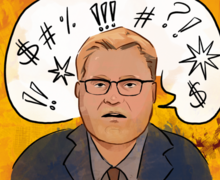Despite nationwide increase in adjunct professors, numbers remain the same at SU
The number of adjunct professors has increased at colleges nationwide. But at Syracuse University, their numbers have remained relatively stagnant.
Non-tenure-track positions now account for 68 percent of college faculty across the country, according to the American Association of University Professors.
At SU, non-tenure tracks made up about 39 percent of the instructional faculty for the 2011-12 academic year, according to SU’s Office of Institutional Research and Assessment. This has been the case at SU for the past decade.
Adjunct professors are one of the four main types of professors employed at SU. The other three types are tenure-track professors, professors of practice and part-time professors, said Vice Chancellor and Provost Eric Spina.
Adjunct professors work part time, typically only teaching one class, as they are often still employed in their profession while teaching at the university, making them a cheaper option for instruction, Spina said.
But Spina said he thinks the decision of what professors to employ focuses far less on financial factors and more on the best way to deliver the curriculum to students.
“We highly value each of the types of faculty members here and recognize for us to best prepare our students for the world, we want our students, over time, to be exposed to all of those types of faculty members,” Spina said.
In addition, Spina said many professors are adjuncts due to their own life situation. Full-time professors are in most cases looking for permanence, while some professors are part time because they don’t want to be tied down or are still looking for the right position somewhere else, he said.
Jeff Simmons, an adjunct professor in the writing department at SU and vice president of the Adjuncts United union, said AU’s goal is to help adjuncts obtain multi-year contracts as well as benefits.
“One of our ongoing issues with the university is to make sure as many faculty get that as possible,” Simmons said. “The highest benefits for adjuncts mean that they’re at the university longer, which provides more continuity for students.”
Like many adjunct professors, Simmons is currently working at both SU and the State University of New York College of Environmental Science and Forestry. He said adjuncts with multiple jobs may have to limit office hours, but because he is always accessible via email, he doesn’t feel it affects his ability to stay in contact with students.
“I feel like mine get plenty enough of me,” Simmons said.
Maura Cyr, a sophomore finance major, said adjunct professors being off campus would only cause problems for her if they didn’t keep in touch via email.
“I personally am not much of a person who’s ever going to go to office hours or anything like that,” Cyr said. “Obviously a lot of people are, so I could see where that would be a problem for them.”
Simmons has been an adjunct professor at many colleges including Onondaga Community College, Le Moyne College and now SU and ESF. If he were to move, he said he knows that as an adjunct he could probably find another job.
Said Simmons: “But I’m happy where I’m at.”
Published on November 13, 2012 at 11:24 pm





